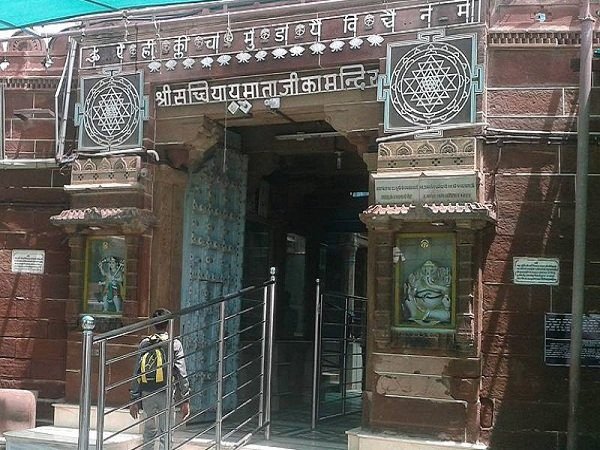The Sachchiya Mata Temple is located in Osian, near the city of Jodhpur in the Indian state of Rajasthan.
The mother goddess Sachiya (also spelled as Sachayay Mata and Sachchiyay Mata, Hindi: सच्चियाय माता / सच्चिया माता) is worshiped there by Kshatriya Swarnakar (Kulthiya families), Marwadi, Oswal, Maheshwari, Karnawat and Mahecha Rajputs (Maru Kansara Soni of Berajara Soni -Kutch). Panwar Rajputs / Parmar Rajputs, Kumawat, Oswal, Charans, Jains, Pareek Brahmins, and many other castes living in Rajasthan, Gujarat, Madhya Pradesh, and Northern India. The temple was built by King Upendre of Parmar for his Kuldevi in the 9th to 10th century AD.
Maa Jagat Bhawani Shri Sachchiyay Mataji was historically called Shri Osiya Mataji.
An archaeological team found many samples, statues and paintings there. Representations included the ancient deity of Harihar (half Shiva and half Vishnu), Vasudeva with baby Krishna on his head, Krishna fighting a horse, the killing of Putna, Kalidaman, Govardhan dharan and the theft of butter along with images of Balram who seem to represent him as the incarnation of Seshnaga.
Osiya was once a great city. Telivada was located 4.8 km (3 miles) away in the town of Tinvari. Pandit ji ki Dhani (now the small town of Pandit pur) is 6 miles (9.7 km) away. Another 6 miles (9.7 km) away is Kshatripura. 24 miles (39 km) is Lohavat, home to blacksmiths. 108 Jain temples were found in Osiya.
Osiya is located about 25 miles (40 km) from Jodhpur, Rajasthan. It is connected by roads and trains to Jodhpur and Pokharan.
The goddess Sachi was the daughter of King Pauloma of Asura. The benevolent King Pauloma ruled a great kingdom, patronizing many Brahmins (eg Shukracharya). Vrut (Vritra) was the head of Pauloma’s army and wanted to marry Sachi. However, Sachi considered this proposal an insult, since she did not want to marry a servant of her father. Knowing Sachi’s thoughts, Vrut left Pauloma’s service and worshiped Lord Shiva, a common god of the Asuras. Shiva gave Vrut his blessings and the blessing that he could not be killed by any known weapon. Vrut, with his magic, assembled a great army and, with this virtue of immortality, set out to conquer the Aryan lands and forge a kingdom greater than that of Pauloma.
It was the duty of Indra, the king of the gods, to defend the kingdom of Vrut. Knowing that Vrut had the blessing of immortality, Indra approached the sage Dadhichi, as Dadhichi had harder bones than any known weapon. Dadhichi gave his bones to Indra, performing a self-sacrifice, and Indra prepared a weapon, known as Vajra, from these bones. (The highest award of bravery in India, the Param Vir Chakra, bears the symbol of Vajra.) Since the bones had never been used as a weapon before, this challenged the condition of immortality for Vrut.
The armies met on the battlefield, but Indra proposed that instead of allowing all forces to fight, which resulted in great carnage, he and Vrut alone should fight; the victor would take over the other’s army and marry Sachi. Indra emerged victorious from this challenge.
According to Muni Sri Gyan Sunderji, the founding day of Oswals falls on the fourteenth day of Krishna Paksha in the month of Shravan. All Jain-Oswals celebrate this with sacrifice, prayers, and meditation.
Maa Jagat Bhawani Shri Sachchiyay Mataji also called Shri Osiya Mataji is Kuldevi of Oswals.
A large Chamunda Mata temple was built in Upkeshpur, currently known as Osiya. The temple was known to Chamatkars and attracted many worshipers. During Navratri, buffalo were slaughtered and people gave offerings of buffalo meat to please Chamunda Mata. Jain Acharya Shri Ratna Prabh Suri stopped this practice of killing animals. Because of this, the goddess became angry and created pain in the Acharya’s eyes. She did not stagger but continued under this suffering, and Chamunda Mata was ashamed and asked the Acharya for forgiveness.
A stone inscription, in the Jain temple of Osian, gives a different story about the name of Sachiya Mata. According to this story, a Jain monk, Acharya Shrimad Vijay Ratnaprabhasuriji Maharaj Sahib, visited the city of Osian to perform the ceremony known as Anjan Salakha, in the newly created temple of God Mahaveer, around AD 43. The Mahavir temple had been built by Uhad, who was a minister to King Upaldeo; at that time, Osian was known as Upkeshpur. A temple of Jagat Bhavani (Great Goddess) Chamunda Mata was in the city of Upkeshpur. To receive the grace of the goddess, male buffalo sacrifices were often made in the temple during the Navratri festival.
When the Jain monk Vijay Ratnaprabhasuriji Maharaj learned of this practice, he felt a deep sympathy for the sacrificed animals. Using his influence over the minister and the king, he convinced them to forbid this practice. A temple in Katraj (Pune) is dedicated to Sachchiya Mata (Osiya Mata), near the Swetamber Jain temple of Katraj. In his temple, Sachiya Mata-Ji is worshiped with lapsi (an Indian sweet dish), saffron, sandalwood, and incense.


0 Comments